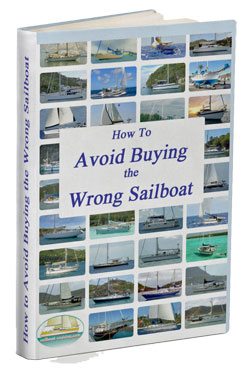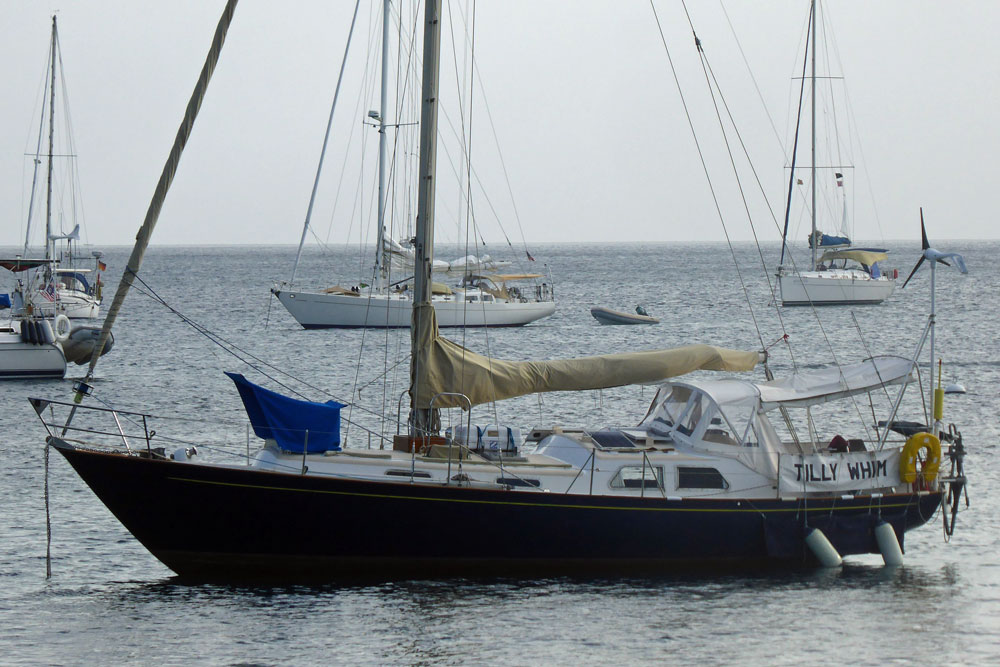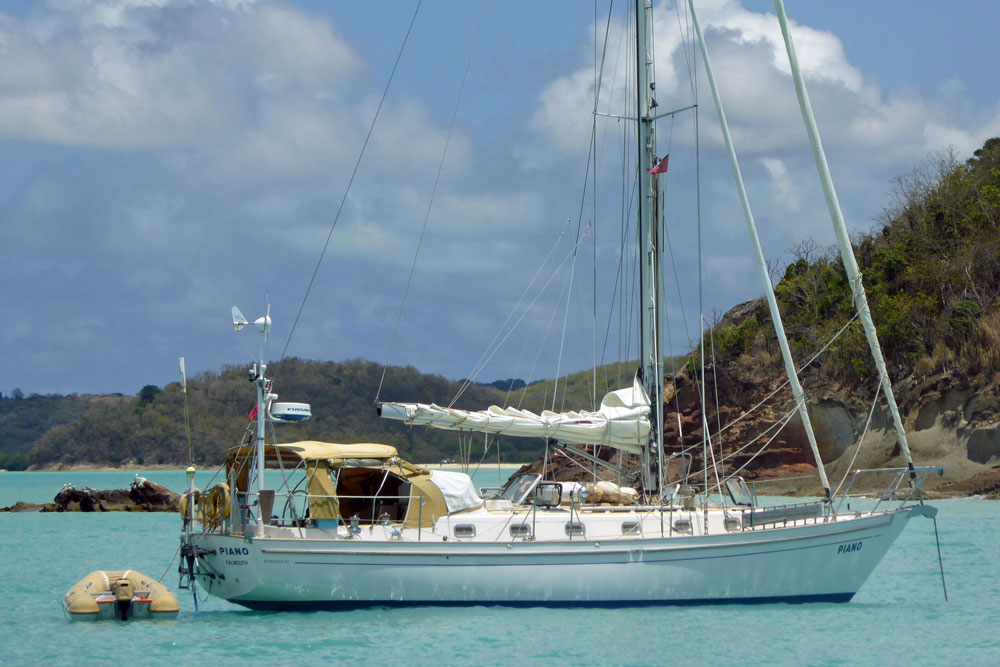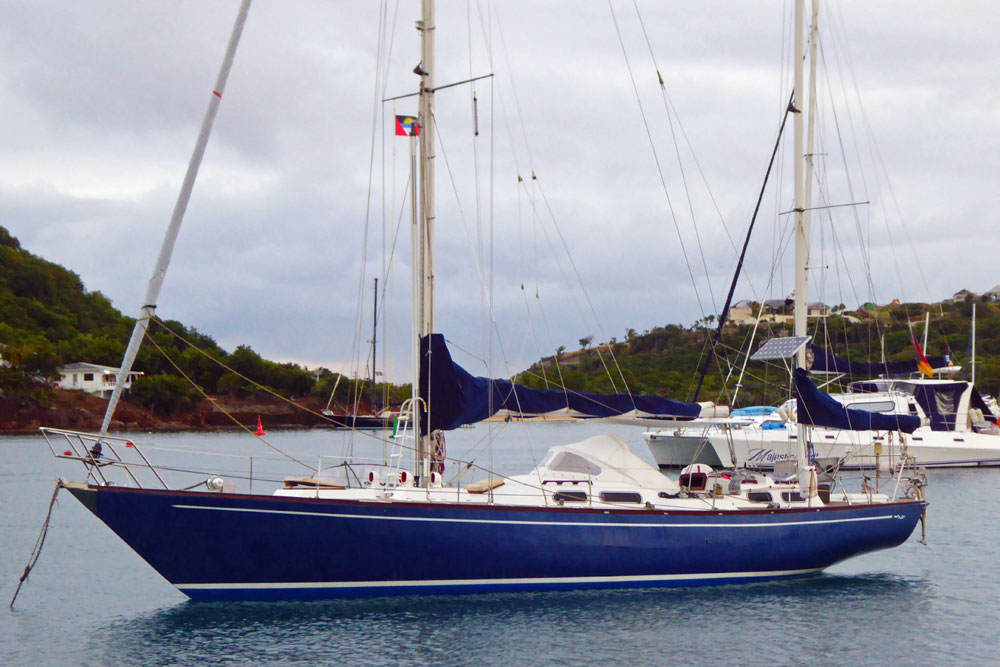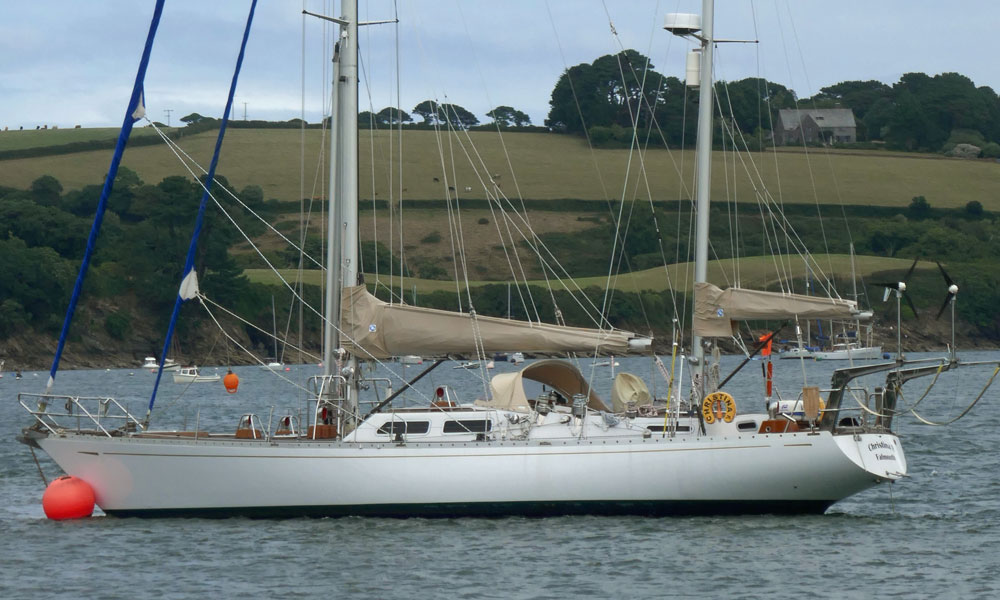- Home
- Cruising Yachts 35' to 40'
- Bowman 40
The Bowman 40 Sailboat
Specs & Key Performance Indicators
The Bowman 40, an aft-cockpit cutter, was designed by Chuck Paine and built in the UK by Southern Boat Building Ltd.
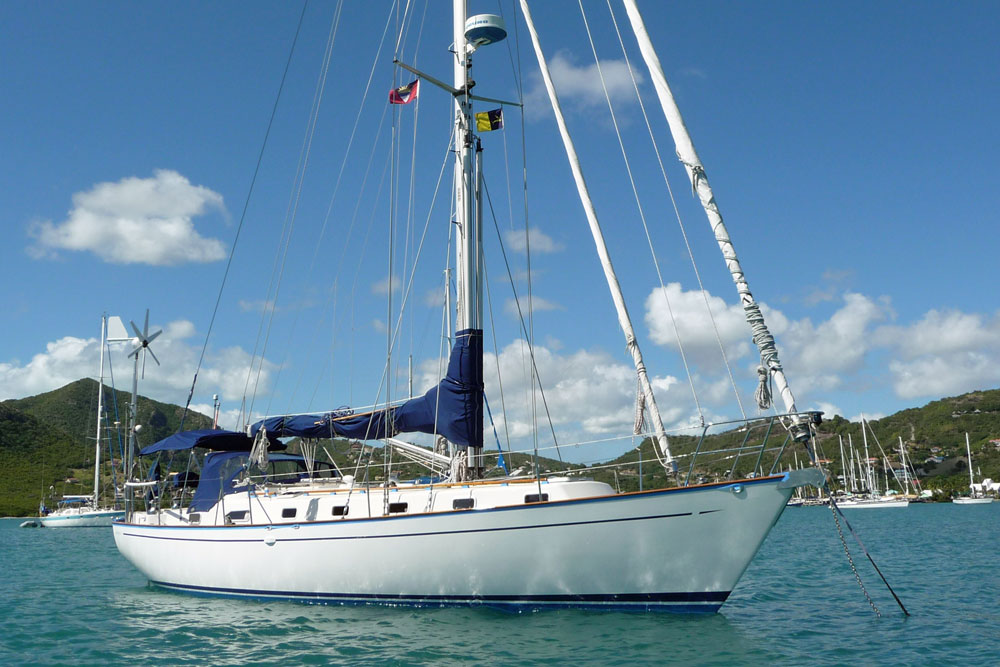 A Bowman 40
A Bowman 40Published Specification for the Bowman 40
Underwater Profile: Scheel keel & skeg-hung rudder
Hull Material: GRP (Fibreglass)
Length Overall: 39'11" (12.2m)
Waterline Length: 32'0" (9.8m)
Beam: 12'7" (3.8m)
Draft: 4'11" (1.5m)
Rig Type: Cutter
Displacement: 19,000lb (8,618kg)
Designer: Chuck Paine
Builder: Southern Boat Building Ltd (UK)
Year First Built: 1987
Published Design Ratios for the Bowman 40
Sail Area/Displacement Ratio: 16.8
Ballast/Displacement Ratio: Not published
Displacement/Length Ratio: 259
Comfort Ratio: 29.3
Capsize Screening Formula: 1.9
Summary Analysis of the Design Ratios for the Bowman 40
1. A Sail Area/Displacement Ratio of 16.8 suggests that the Bowman 40 will, in the right conditions, approach her maximum hull speed readily and satisfy the sailing performance expectations of most cruising sailors.
2. In the absence of any published Ballast/Displacement for the Bowman 40 we are unable to make any assessment of this element of her stiffness under sail, but this review by Yachting Monthly says "she’s stiff and easily capable of standing up to her canvas".
3. A Displacement/Length Ratio of 259, tells us the Bowman 40 is a moderate displacement cruiser, which means she'll carry all your cruising gear without it having a dramatic effect on her performance. Most of today's sailboats intended for offshore cruising fall into this displacement category.
4. Ted Brewer's Comfort Ratio of 29.3 suggests that crew comfort of a Bowman 40 in a seaway is similar to what you would associate with the motion of a moderate bluewater cruising boat - a predictable and acceptable motion for most seasoned sailors.
5. The Capsize Screening Formula (CSF) of 1.9 indicates that a Bowman 40 would be a safer choice of sailboat for an ocean passage than one with a CSF of more than 2.0.
Bowman 40: A Comfortable Ocean Cruiser
The Bowman 40, a medium-to-heavy displacement yacht has a classic design and a proven track record of blue water cruising.
Overview
The Bowman 40 was designed by Chuck Paine and built by Southern Boat Building in the UK starting in 1987. It is a development of the earlier Bowman 40 designed by Jack Laurent Giles and built by Emsworth Marine in the UK starting in 1974. The Paine version has a more modern hull shape, a longer waterline, a taller rig and a deeper keel than the Giles version. Both versions share the same cutter rig, long keel and skeg-hung rudder.
The Bowman 40 is a well-built and well-equipped yacht that can handle any weather and sea conditions. It has a deep-bilged hull with an overhanging bow and narrowish shoulders, which gives it a powerful but sea-kindly motion. It has a stiff and balanced sail plan that can be easily reefed and trimmed. It has a spacious and comfortable cockpit that can be enclosed with a sprayhood and bimini. It has a solid teak interior with ample storage and ventilation.
The Bowman 40 is not a racer, but neither is it a slouch. It can maintain good average speeds on long passages, thanks to its momentum and ability to carve through heavy seas. It is also capable of sailing close to the wind, thanks to its long keel and skeg. It has a shoal draught of 1.68 m (5.51 ft), which allows it to explore shallow waters and dry out alongside a wall on its keel base.
The Bowman 40 is ideal for couples or small families who want to sail around the world in comfort and safety. It can accommodate up to six people in two cabins and the saloon, but it is more suited for four people who value space and privacy. It has a large galley, a generous saloon table, a roomy heads compartment, a wet locker and a full-depth cockpit locker.
Accommodation
The Bowman 40 has a traditional layout with two cabins: one forward and one aft. The forward cabin has a V-berth with an infill cushion to make it into a double berth. There are lockers above and below the berth, as well as shelves along the hull sides. There is an opening hatch above the berth for light and ventilation.
The aft cabin has a double berth that spans across the stern. There are lockers above and below the berth, as well as shelves along the hull sides. There is an opening portlight above the berth for light and ventilation.
The saloon has two settees that can be used as single berths. The starboard settee can be pulled out to make it into a wider berth. There are lockers above and behind the settees, as well as shelves along the hull sides. There is a large drop-leaf table in the center of the saloon, which can seat six people comfortably. There are four opening portlights and two opening hatches in the saloon for light and ventilation.
The galley is located on the port side of the companionway. It has a U-shaped layout with ample counter space and storage. It has a three-burner stove with oven, a double sink with hot and cold water, a top-loading fridge with freezer compartment, and several drawers and lockers for utensils and provisions.
The navigation station is located on the starboard side of the companionway. It has a large chart table with storage underneath, an instrument panel with VHF radio, GPS, radar, autopilot, wind speed/direction indicator, depth sounder, log/speedometer, compass and battery monitor. There is also a swivel seat with storage underneath.
The heads compartment is located on the port side between the saloon and the forward cabin. It has a manual marine toilet, a washbasin with hot and cold water, a shower with curtain, a mirror, a cabinet and several hooks for towels and clothes. There is an opening portlight for light and ventilation.
Hull and Deck
The Bowman 40 has a hand-laid fiberglass hull with a balsa core above the waterline and a solid laminate below. The hull is reinforced with stringers and bulkheads, and has a white gelcoat finish. The deck is also hand-laid fiberglass with a balsa core, and has a molded-in nonskid pattern. The deck is bonded and bolted to the hull with an aluminum toe rail.
The Bowman 40 has a flush deck with a raised coachroof that provides good headroom below. The coachroof has four opening hatches and two dorade vents for light and ventilation. The foredeck has a large anchor locker with an electric windlass, a bow roller, a bow sprit and a chain stopper. There are also two mooring cleats, two fairleads and a stainless steel pulpit.
The side decks are wide and uncluttered, with teak handrails on the coachroof and stainless steel stanchions and lifelines along the edges. There are also four mooring cleats, four fairleads, two genoa tracks, two genoa winches, two staysail tracks, two staysail winches, two dorade vents and two fuel fillers on the side decks.
The cockpit is spacious and comfortable, with teak seats and sole. It has a pedestal-mounted wheel steering with a binnacle compass, engine controls and instrument pod. There is also a folding cockpit table, a cockpit locker, a gas locker, a stern locker, a stern rail with seats, a boarding ladder, an outboard bracket, a flag staff and a stainless steel pushpit.
Mast and Rigging
The Bowman 40 has a cutter rig with a single-spreader aluminum mast and boom. The mast is keel-stepped and has internal halyards and wiring. The boom has an internal outhaul and reefing lines. The rigging is stainless steel wire with swaged terminals and turnbuckles. The sail area is 86.4 m2 (930 ft2).
The Bowman 40 has a roller-furling genoa, a roller-furling staysail and a slab-reefing mainsail. The sails are made of Dacron and have UV protection strips. The genoa has foam luff padding and telltales. The staysail has hanks and telltales. The mainsail has three reef points, battens, leech line and telltales.
The Bowman 40 has four self-tailing winches: two Lewmar 48 for the genoa sheets, and two Lewmar 30 for the staysail sheets. There are also four winches on the mast: two Lewmar 30 for the halyards, one Lewmar 16 for the reefing lines, and one Lewmar 8 for the topping lift. There are also several rope clutches, blocks, cleats and jammers for the running rigging.
Keel and Rudder
The Bowman 40 has a long keel with an external lead ballast. The keel is bolted to the hull with stainless steel bolts. The keel provides good directional stability and protects the propeller and rudder from grounding damage. The keel draft is 1.68 m (5.51 ft).
The Bowman 40 has a skeg-hung rudder with a stainless steel stock and bronze fittings. The rudder is connected to the wheel steering by cables and pulleys. The rudder provides good maneuverability and balance.
Conclusion
The Bowman 40 is a classic ocean cruiser that offers comfort, safety and performance. It is well-built and well-equipped for long-distance sailing. It has a spacious and cozy interior with ample storage and ventilation. It has a powerful but sea-kindly hull with a long keel and skeg-hung rudder. It has a cutter rig with roller-furling sails that can be easily handled by a small crew.
This article was written with the assistance of Gemini, a large language model developed by Google. Gemini was used to gather information, summarize research findings, and provide suggestions for the content and structure of the article.
Other sailboats in the Bowman range include:
Recent Articles
-
Is Marine SSB Still Used?
Apr 15, 25 02:05 PM
You'll find the answer to this and other marine SSB-related questions right here... -
Is An SSB Marine Radio Installation Worth Having on Your Sailboat?
Apr 14, 25 02:31 PM
SSB marine radio is expensive to buy and install, but remains the bluewater sailors' favourite means of long-range communication, and here's why -
Correct VHF Radio Procedure: Your Questions Answered
Apr 14, 25 08:37 AM
Got a question about correct VHF radio procedure? Odds are you'll find your answer here...
